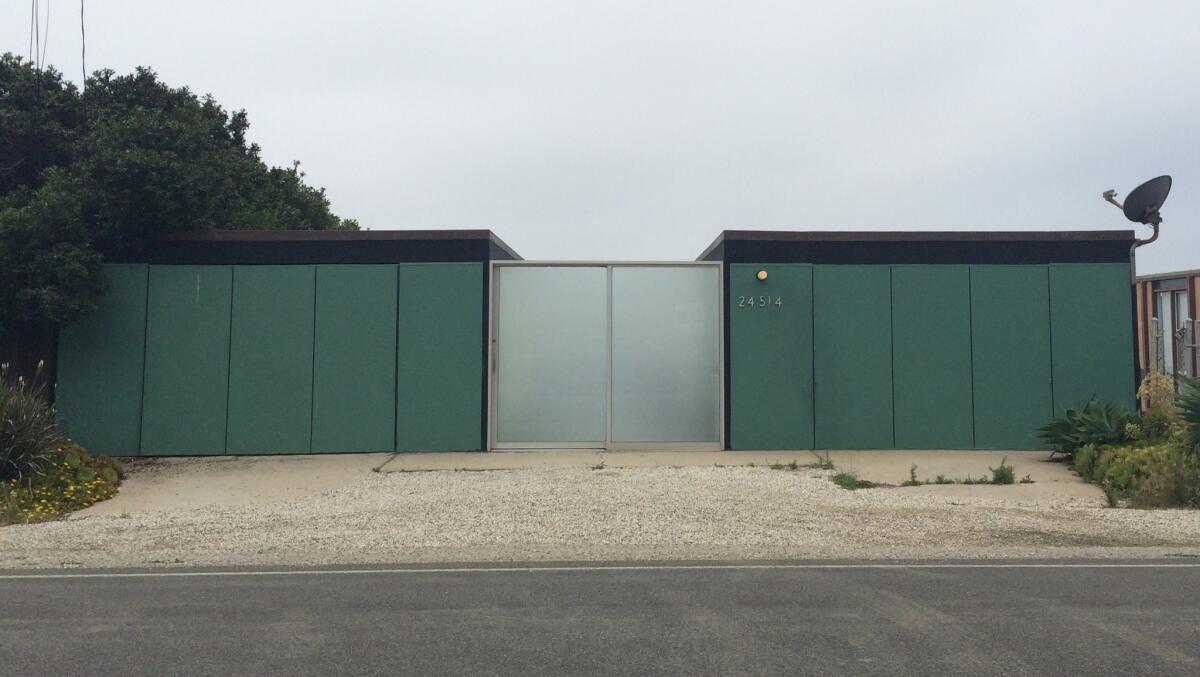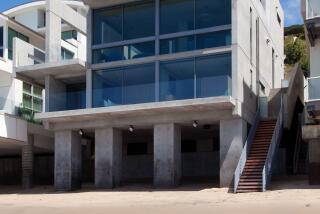Is Craig Ellwood’s beachfront Hunt House in jeopardy?

The 1957 Hunt House, by architects Craig Ellwood and Jerrold Lomax, as it looks today.
- Share via
According to documents filed with the city of Malibu, the owner of a legendary beachfront house by architect Craig Ellwood wants to demolish it.
Last fall, the Malibu Planning Commission considered (and ultimately postponed a decision on) an application to replace the house on Malibu Road with “a new 28-foot-tall, two-story, 5,511-square foot single-family residence.”
The existing house at that location, covering 1,335 square feet, is known as the Hunt House. It was designed by Ellwood and one of his key design partners, Jerrold Lomax, for Victor and Elizabeth Hunt and completed in 1957.
The house, last sold in 2012 for $5.3 million, does not look to be in great shape. From the beach side, in particular, some signs of neglect are visible.
Still, its original design appears largely intact. And to lose this house would be a major blow to the postwar architectural heritage of Los Angeles.
It is without doubt one of most important remaining modern houses in Southern California, propelled by 1950s confidence about L.A.’s postwar future (and even more impressive, in its ability to pare down design ideas to their minimalist essence, than Ellwood’s intelligently restored Pierson House just down the road, which was finished a year or so earlier).
It is also proof that the crisp, streamlined approach to L.A. postwar residential modernism that we associate most closely with hillside lots, thanks in large part to the Case Study program, can work brilliantly at the beach.
The plan is elegantly simple. Two small garages along the street flank an interior court leading down to the house itself, a rectangular box with a deck along the beach side and an interior featuring a see-through fireplace in the center of the living room, beneath a skylight.
The house is opaque and guarded as it faces the street and much more open, not surprisingly, toward the beach. The overall effect is graceful and direct, bordering on delicate. (David Gebhard and Robert Winter, in their guidebook to L.A. architecture, write that the house embodies “the Case Study House image of the 1950s -- Miesian, cardboardy, and fragile.”)
According to Matt Myerhoff, media information officer for the city of Malibu, a neighbor concerned about the possible demolition “had her attorney write a letter saying that a study was needed to determine if the house was historically significant enough to prevent the demolition permit. The house owner’s lawyer agreed but never did anything after for which there is a record. The demo permit item is still listed as continued.”
The owner of the property is listed as Ardie Tavangarian. There is an architect of that name at a firm called Arya Group, which according to a story in the Wall Street Journal designed a 25,000-square foot house in Beverly Hills for Jackie Collins.
Tavangarian did not respond to a phone call and an email seeking comment. News of the possible demolition appeared on the design blog Esoteric Survey.
More to Read
The biggest entertainment stories
Get our big stories about Hollywood, film, television, music, arts, culture and more right in your inbox as soon as they publish.
You may occasionally receive promotional content from the Los Angeles Times.











